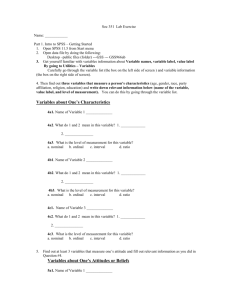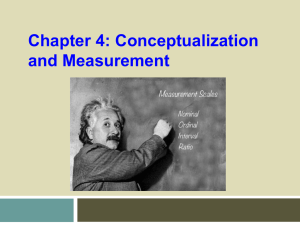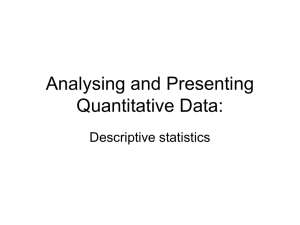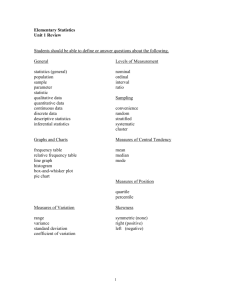Review of Statistics
advertisement
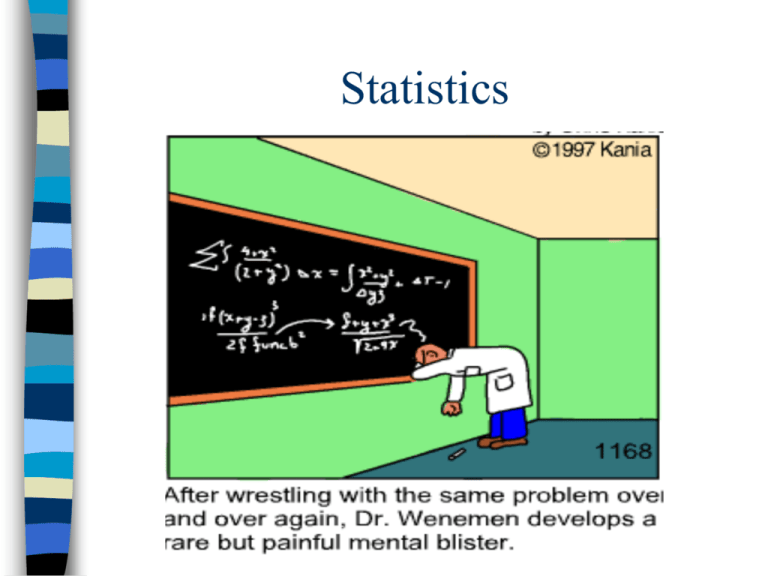
Statistics Review of Statistics Levels of Measurement Descriptive and Inferential Statistics Levels of Measurement Nature of the variable affects rules applied to its measurement Qualitative Data Nominal Ordinal Quantitative Data Interval Ratio Nominal Measurement Lowest Level Sorting into categories Numbers merely symbols--have no quantitative significance Assign equivalence or nonequivalence Examples, gender, marital status, etc Male / female smoker /nonsmoker alive/dead 1 2 Rules of Nominal system All of members of one category are assigned same numbers No two categories are assigned the same number (mutual exclusivity) Cannot treat the numbers mathematically Mode is the only measure of central tendency The Ordinal Scale Sorting variations on the basis of their relative standing to each other Attributes ordered according to some criterion (e.g. best to worst) Intervals are not necessarily equal Should not treat mathematically, frequencies and modes ok Ordinal scale 0 1 2 3 4 Interval Scale Researcher can specify rank ordering of variables and distance between Intervals are equal but no rational zero point (example IQ scale, Fahrenheit scale) Data can be treated mathematically, most statistical tests are possible Ratio Scale Highest level of measurement Rational meaningful zero point Absolute magnitude of variable (e.g., mgm/ml of glucose in urine) Ideal for all statistical tests Descriptive Statistics Used to describe data Frequency distributions, histograms, polygons Measures of Central Tendency Dispersion Position within a sample Frequency Distributions Imposing some order on a mass of numerical data by a systematic arrangement of numerical values from lowest to highest with a count of the number of times each value was obtained--Most frequently represented as a frequency polygon Frequency distribution 30 25 Frequency 20 15 10 5 0 Shapes of distributions Symmetry Modality Kurtosis Symmetry Normal curve symmetrical If non symmetrical skewed (peak is off center) – positively skewed – negatively skewed Positive skew Negative skew Modality Describes how many peaks are in the distribution – unimodal – bimodal – multimodal unimodal bimodal multimodal Kurtosis Peakedness of distribution – platykurtic – mesokurtic – leptokurtic Mesokurtic Platykurtic Leptokurtic Measures of Central Tendency Overall summary of a group’s characteristics “What is the average level of pain described by post hysterectomy pts.?” “How much information does the typical teen have about STDs?” Mean Arithmetic average Most widely reported meas. of CT Not trustworthy on skewed distributions Median The point on a distribution above which 50% of observations fall Shows how central the mean really is since the median is the number which divides the sample in half Does not take into account the quantitative values of individual scores Preferred in a skewed distribution Mode The most frequently occuring score or number value within a distribution Not affected by extreme values Shows where scores cluster There may be more than one mode in a distribution Arrived at through inspection limited usefulness in computations Which measures of central tendency is represented by each of these lines? Variability or Dispersion Measures Percentile rank-the point below which a % of scores occur Range --highest-lowest score Standard deviation--master measure of variability--average difference of scores from the mean--allows one to interpret a score as it relates to others in the distribution Normal (Gaussian) Distribution Mathematical ideal – 68.3% of scores within +/- 1sd – 95.4% of scores within +/- 2sd – 99.7% of scores within +/- 3sd unimodal mesokurtic symmetrical Normal curve 1% 13.5% 34% 34% 13.5 % 1% Inferential Statistics Used to make inferences about entire population from data collected from a sample Two classifications based on their underlying assumptions Parametric Nonparametric Parametric Based on population parameters Have numbers of assumptions (requirements) Level of measurement must be interval or ratio – t-test – Pearson product moment correlation ® – ANOVA – Multiple regression analysis Parametric Preferable because they are more powerful--better able to detect a significant result if one exists. Nonparametric Not as powerful Have fewer assumptions Level of measurement is nominal or ordinal – Chi squared Some examples of Statistical tests and their use Statistical Test Purpose IV DV t-test (t) To test the difference between 2 gp. means nominal Interval or ratio ANOVA (F) To test the difference of means among 3or more gps To test that a relationship exists Nominal Interval or ratio Interval or ordinal Interval or ordinal Pear. Prod Mom. Corr (r ) Chi Squared test (X2) To test the differences Nominal in proportions in 2 or more groups to determin if results are possible due to chance Nominal analysed with: Analyse-It + General v Test Chi-square test Caffeine consumption of adults Marital status by Caffeine consumption Performed by Analyse-it Software, Ltd. n Count Marital status Married 3888 0 Total 652 (705.8) 36 (32.9) 218 (167.3) 906 X² statistic p 51.66 <0.0001 Divorced, seperated, widowed Single Date Caffeine consumption 1-150 151-300 1537 598 (1488.0) (578.1) 46 38 (69.3) (26.9) 327 106 (352.7) (137.0) 1910 742 >300 242 (257.1) 21 (12.0) 67 (60.9) 330 Total 3029 141 718 3888 1 February 1999 Hypothesis testing Research Hypothesis Hr--Statement of the researcher’s prediction Alternate Hypothesis Ha--Competing explanation of results Null Hypothesis Ho -- Negative Statement of hypothesis tested by statistical tests Research Hypotheses Method A is more effective than method B in reducing pain (directional) Method A will differ from Method B in pain reducing effectiveness (nondirectional) Null Hypothesis Method A equals Method B in pain reduction effectiveness.(any difference is due to chance alone This must be statistically tested to say that something else beside chance is creating any difference in results Type I and Type II errors Type I--a decision to reject the null hypothesis when it is true. A researcher conludes that a relationship exists when it does not. Type II--a decisioon to accept the null hypothesis when it is false. The researcher concludes no relationship exists when it does. Level of Significance Degree of risk of making a Type one error. (saying a treatment works when it doesn’t or that a relationship exists when there is none) Signifies the probability that the results are due to chance alone. p=.05 means that the probability of the results being due to chance are 5%


